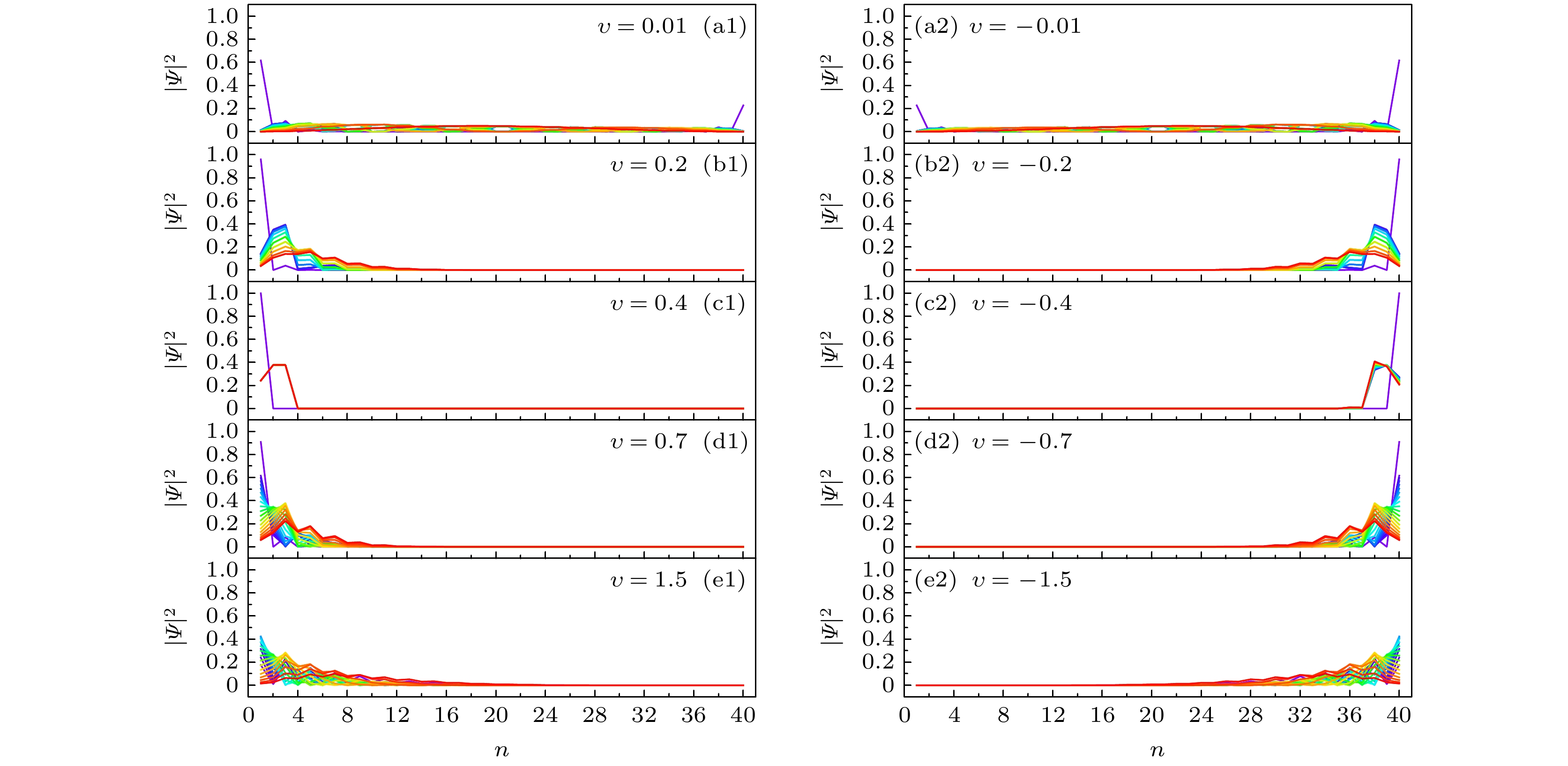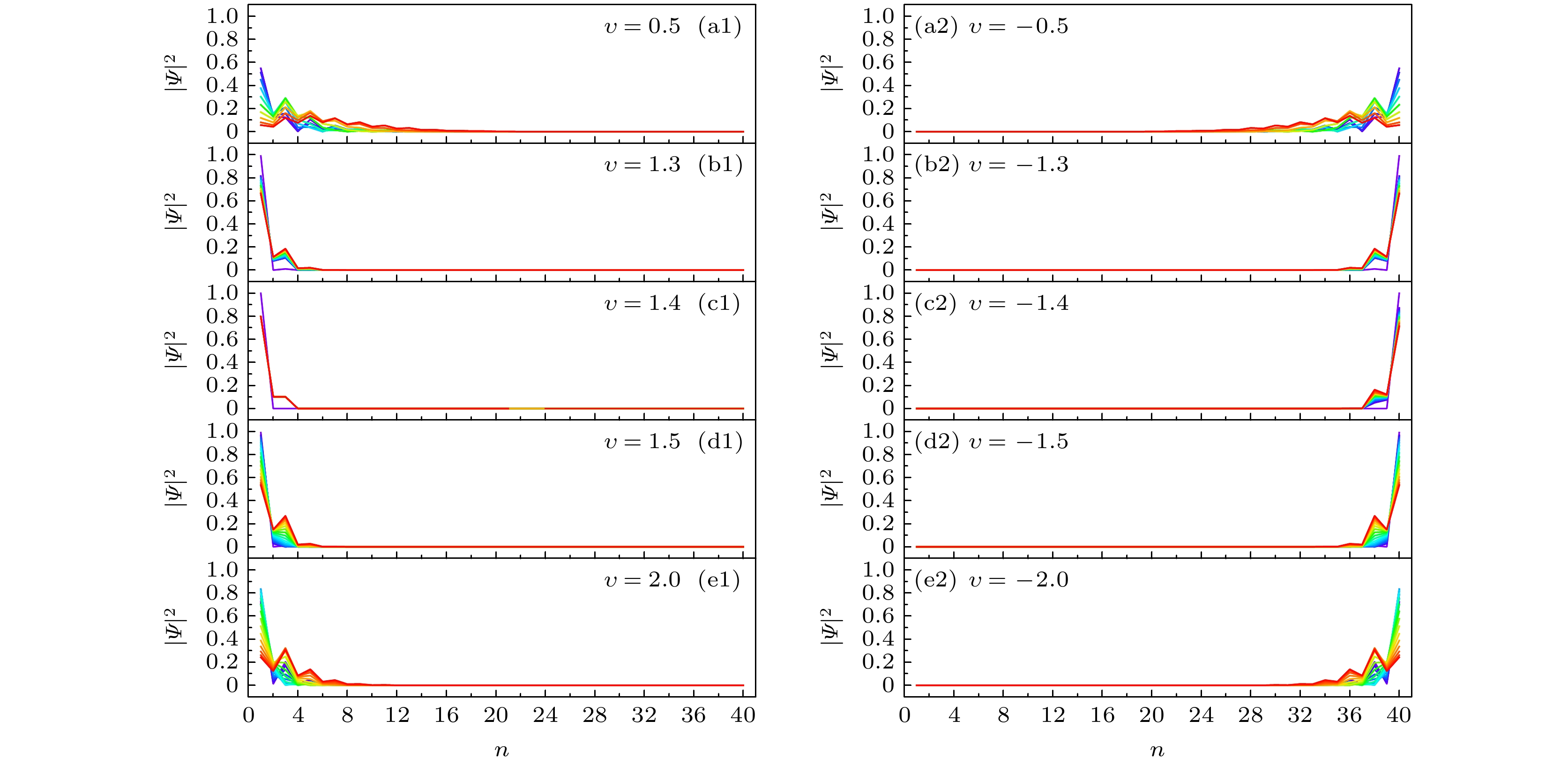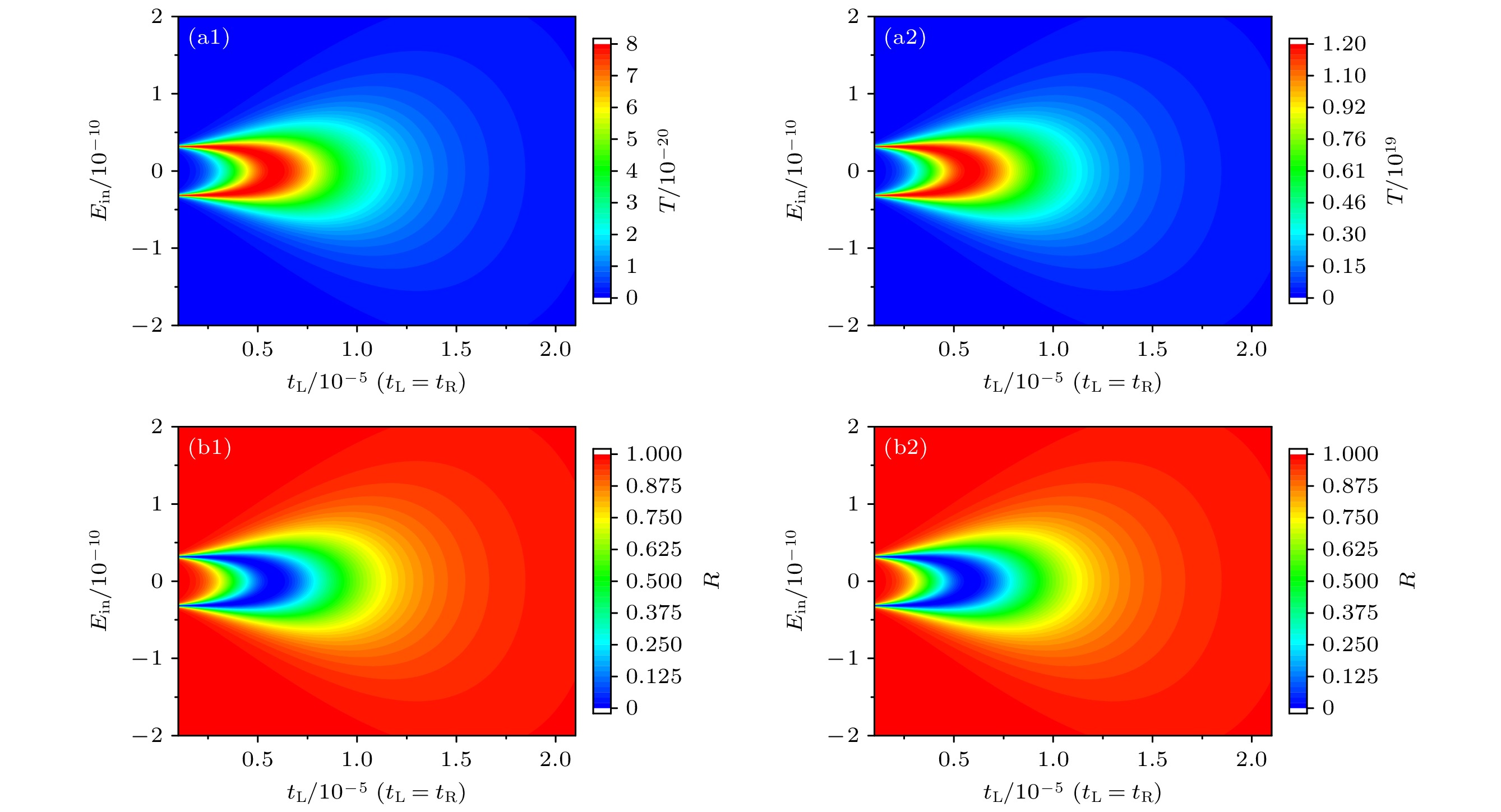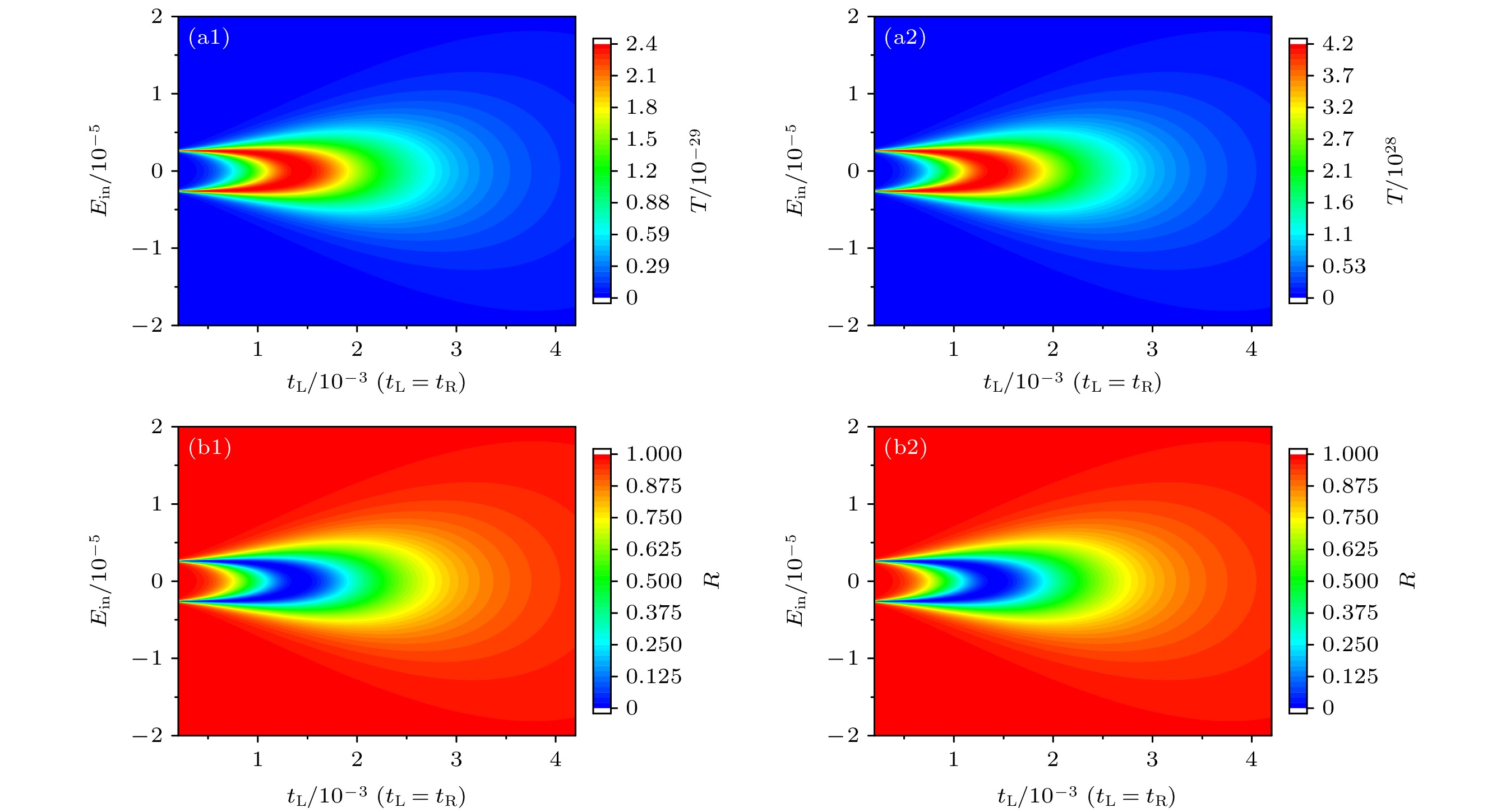-
In the non-reciprocal Su-Schrieffer-Heeger (SSH) chain, the hopping amplitude of an electron in the intra-cell depends on its hopping direction. Consequently, the non-Hermitian SSH chain has both non-trivial topological edge state and non-Hermitian skin effect. However, how to detect the non-trivial topological edge states and non-Hermitian skin effect has become an important topic in non-Hermitian physics. In this paper, we study the relationships of the non-trivial topological edge states and the non-Hermitian skin effect of non-Hermitian SSH chain with their electron transport properties in the vicinity of the zero energy. It is demonstrated that when the peak value of the electron transmission probability in the vicinity of the zero energy is much smaller than 1, the non-Hermitian SSH chain has a left-non-Hermitian skin effect; while that in the vicinity of the zero energy is much larger than 1, the non-Hermitian SSH chain has a right-non-Hermitian skin effect. In particular, the skin effect of non-Hermitian SSH chain can be further enhanced in the region of non-trivial topological edge states. Moreover, with the increase of the electron tunneling coupling amplitudes between the non-Hermitian SSH chain and the left and right leads from the weak coupling regime to the strong coupling one, the number of the dips of reflection probability in the vicinity of the zero energy will change from two to zero. Therefore, these results theoretically provide an alternative scheme for detecting non-trivial topological edge states and non-Hermitian skin effect types of the non-Hermitian SSH chain.
-
Keywords:
- edge states /
- non-Hermitian skin effect /
- non-Hermitian Su-Schrieffer-Heeger chain /
- reflection probability /
- transmission probability
[1] Ashida Y, Gong Z, Ueda M 2020 Adv. Phys. 69 249
 Google Scholar
Google Scholar
[2] Bergholtz E J, Budich J C, K Flore K 2021 Rev. Mod. Phys. 93 015005
 Google Scholar
Google Scholar
[3] Zhang X, Zhang T, Lu M H, Chen Y F 2022 Adv. Phys. -X 7 2109431
 Google Scholar
Google Scholar
[4] Li A, Wei H, Cotrufo M, Chen W, Mann S, Ni X, Xu B, Chen J, Wang J, Fan S, Qiu CW, Alù A, Chen L 2023 Nat. Nanotechnol. 18 706
 Google Scholar
Google Scholar
[5] Banerjee A, Sarkar R, Dey S, Narayan A 2023 J. Phys. Condens. Matter 35 333001
 Google Scholar
Google Scholar
[6] Heiss W D 2012 J. Phys. A: Math. Theor. 45 444016
 Google Scholar
Google Scholar
[7] Mandal I, Bergholtz E J, 2021 Phys. Rev. Lett. 127 186601
 Google Scholar
Google Scholar
[8] Wang Q, Chong Y D 2023 J. Opt. Soc. Am. B 40 1443
 Google Scholar
Google Scholar
[9] Helbig T, Hofmann T, Imhof S, Abdelghany M, Kiessling T, Molenkamp L W, Lee C H, Szameit A, Greiter M, ThomaleR 2020 Nat. Phys. 16 747
 Google Scholar
Google Scholar
[10] Xiao L, Deng T, Wang K, Zhu G, Wang Z, Yi W, Xue P 2020 Nat. Phys. 16 761
 Google Scholar
Google Scholar
[11] Ghataka A, Brandenbourgera M, van Wezela J, Coulaisa C 2020 Proc. Natl. Acad. Sci. U. S. A. 117 29561
 Google Scholar
Google Scholar
[12] Lee T E 2016 Phys. Rev. Lett. 116 133903
 Google Scholar
Google Scholar
[13] Jin L, Song Z 2019 Phys. Rev. B 99 081103(R
 Google Scholar
Google Scholar
[14] Wang X R, Guo C X, Kou S P 2020 Phys. Rev. B 101 121116(R
 Google Scholar
Google Scholar
[15] Wang X R, Guo C X, Du Q, Kou S P 2020 Chin. Phys. Lett. 37 117303
 Google Scholar
Google Scholar
[16] Jezequel L, Delplace P 2023 Phys. Rev. Lett. 130 066601
 Google Scholar
Google Scholar
[17] Zeuner J M, Rechtsman M C, Plotnik Y, Lumer Y, Nolte S, Rudner M S, Segev M, SzameitA 2015 Phys. Rev. Lett. 115 040402
 Google Scholar
Google Scholar
[18] Weimann S, Kremer M, Plotnik Y, Lumer Y, Nolte S, Makris K G, Segev M, Rechtsman M C, Szameit A 2017 Nat. Mater. 16 433
 Google Scholar
Google Scholar
[19] Weidemann S, Kremer M, Helbig T, Hofmann T, Stegmaier A, Greiter M, Thomale R, Szameit A 2020 Science 368 311
 Google Scholar
Google Scholar
[20] Liu S, Shao R, Ma S, Zhang L, You O, Wu H, Xiang Y J, Cui T J, Zhang S 2021 Research 2021 5608038
 Google Scholar
Google Scholar
[21] Liang Q, Xie D, Dong Z, Li H, Li H, Gadway B, Yi W, Yan B 2022 Phys. Rev. Lett. 129 070401
 Google Scholar
Google Scholar
[22] Zhou Q, Wu J, Pu Z, Lu J, Huang X, Deng W, Ke M, Liu Z, 2023 Nat. Commun. 14 4569
 Google Scholar
Google Scholar
[23] Feng Y, Liu Z, Liu F, Yu J, Liang S, Li F, Zhang Y, Xiao M, Zhang Z 2023 Phys. Rev. Lett. 131 013802
 Google Scholar
Google Scholar
[24] Zhang H, Chen T, Li L, Lee C H, Zhang X 2023 Phys. Rev. B 107 085426
 Google Scholar
Google Scholar
[25] Lee C H, Thomale R 2019 Phys. Rev. B 99 201103(R
 Google Scholar
Google Scholar
[26] Okuma N, Kawabata K, Shiozaki K, Sato M 2020 Phys. Rev. Lett. 124 086801
 Google Scholar
Google Scholar
[27] Lin Z, Lin Y, Yi W 2022 Phys. Rev. B 106 063112
 Google Scholar
Google Scholar
[28] Zeng Q B 2022 Phys. Rev. B 106 235411
 Google Scholar
Google Scholar
[29] Li J R, Luo C, Zhang L L, Zhang S F, Zhu P P, Gong W J 2023 Phys. Rev. A 107 022222
 Google Scholar
Google Scholar
[30] Tang C, Yang H, Song L, Yao X, Yan P, Cao Y 2023 Phys. Rev. B 108 035410
 Google Scholar
Google Scholar
[31] Kokhanchik P, Solnyshkov D, MalpuechG 2023 Phys. Rev. B 108 L041403
 Google Scholar
Google Scholar
[32] Su W P, SchriefferJ R, HeegerA J 1980 Phys. Rev. B 22 2099
 Google Scholar
Google Scholar
[33] Li H, Yi W 2022 Phys. Rev. A 106 053311
 Google Scholar
Google Scholar
[34] 张蓝云, 薛海斌, 陈彬, 陈建宾, 邢丽丽 2020 物理学报 69 077301
 Google Scholar
Google Scholar
Zhang L Y, Xue H B, Chen B, Chen J B, Xing L L 2020 Acta Phys. Sin. 69 077301
 Google Scholar
Google Scholar
[35] 薛海斌, 段志磊, 陈彬, 陈建宾, 邢丽丽 2021 物理学报 70 087301
 Google Scholar
Google Scholar
Xue H B, Duan Z L, Chen B, Chen J B, Xing L L 2021 Acta Phys. Sin. 70 087301
 Google Scholar
Google Scholar
[36] Ye C Z, Zhang L Y, Xue H B 2022 Chin. Phys. B 31 027304
 Google Scholar
Google Scholar
[37] Yao S, Wang Z 2018 Phys. Rev. Lett. 121 086803
 Google Scholar
Google Scholar
-
图 1 非厄米SSH链与左、右导线耦合系统的示意图, 其中, 小的实心圆(红色)表示A子格, 大的实心圆(绿色)表示B子格, 空心圆(黑色)表示导线上的原子
Figure 1. Schematic diagram of the non-Hermitian SSH chain coupled to the left and right leads. The small solid circles (red) represent the A sublattices, the large solid circles (green) represent the B sublattices, the hollow circles (black) represent atoms on the leads.
图 2 (a1), (a2)非厄米SSH链的能谱图实部; (b1), (b2)非厄米SSH链的能谱图虚部; (c1), (c2)非厄米SSH链的不同缠绕数随着$ \upsilon $的变化图. 其中, (a1), (b1), (c1) $ \gamma = 0.4 $; (a2), (b2)和(c2) $ \gamma = 1.4 $. 非厄米SSH链的其他参数选取为$ w = 1.0 $, $ N = 20 $
Figure 2. (a1), (a2) Real part of the energy spectrum of the non-Hermitian SSH chain; (b1), (b2) imaginary part of the energy spectrum of the non-Hermitian SSH chain; (c1), (c2) the different winding number of the non-Hermitian SSH chain as a function of the value of $\upsilon $. Here, (a1), (b1), (c1) $ \gamma = 0.4 $; (a2), (b2), (c2) $ \gamma = 1.4 $. The other parameters of the non-Hermitian SSH chain are chosen as $ w = 1.0 $ and $ N = 20 $.
图 3 非厄米SSH链在零能附近的本征值的本征态波函数概率幅的绝对值随子格$n$和$ \upsilon $值变化的相图 (a) $\gamma = $$ 0.4$; (b) $\gamma = 1.4$; 非厄米SSH链的其他参数选取为$ w = $$ 1.0 $, $ N = 20 $
Figure 3. Absolute value of probability amplitudes of the wave functions of the nearly zero-energy eigenstates of the non-Hermitian SSH chain as a function of the sublattice $n$and the value of $ \upsilon $: (a) $\gamma = 0.4$; (b) $\gamma = 1.4$. The other parameters of the non-Hermitian SSH chain are chosen as $ w = 1.0 $and $ N = 20 $.
图 4 非厄米SSH链的本征态波函数在每个子格上的概率分布图 (a1) $ \upsilon = 0.01 $; (a2) $ \upsilon = - 0.01 $; (b1) $ \upsilon = 0.2 $; (b2) $ \upsilon = - 0.2 $; (c1) $ \upsilon = 0.4 $; (c2) $ \upsilon = - 0.4 $; (d1) $ \upsilon = 0.7 $; (d2) $ \upsilon = - 0.7 $; (e1) $ \upsilon = 1.5 $; (e2) $ \upsilon = - 1.5 $; 非厄米SSH链的其他参数选取为$\gamma = $$ 0.4$, $ w = 1.0 $, $ N = 20 $
Figure 4. Distribution of probabilities of the wave functions of the non-Hermitian SSH chain: (a1) $ \upsilon = 0.01 $; (a2) $ \upsilon = - 0.01 $; (b1) $ \upsilon = 0.2 $; (b2) $ \upsilon = - 0.2 $; (c1) $ \upsilon = 0.4 $; (c2) $ \upsilon = - 0.4 $; (d1) $ \upsilon = 0.7 $; (d2) $ \upsilon = - 0.7 $; (e1) $ \upsilon = 1.5 $; (e2) $ \upsilon = - 1.5 $. The other parameters of the non-Hermitian SSH chain are chosen as $\gamma = 0.4$, $ w = 1.0 $ and $ N = 20 $.
图 5 非厄米SSH链的本征态波函数在每个子格上的概率分布图 (a1) $ \upsilon = 0.5 $; (a2) $ \upsilon = - 0.5 $; (b1) $ \upsilon = 1.3 $; (b2) $ \upsilon = - 1.3 $; (c1) $ \upsilon = 1.4 $; (c2) $ \upsilon = - 1.4 $; (d1) $ \upsilon = 1.5 $; (d2) $ \upsilon = - 1.5 $; (e1) $ \upsilon = 2.0 $; (e2) $ \upsilon = - 2.0 $; 非厄米SSH链的其他参数选取为$\gamma = $$ 1.4$, $ w = 1.0 $, $ N = 20 $
Figure 5. Distribution of probabilities of the wave functions of the non-Hermitian SSH chain: (a1) $ \upsilon = 0.5 $; (a2) $ \upsilon = - 0.5 $; (b1) $ \upsilon = 1.3 $; (b2) $ \upsilon = - 1.3 $; (c1) $ \upsilon = 1.4 $; (c2) $ \upsilon = - 1.4 $; (d1) $ \upsilon = 1.5 $; (d2) $ \upsilon = - 1.5 $; (e1) $ \upsilon = 2.0 $; (e2) $ \upsilon = - 2.0 $. The other parameters of the non-Hermitian SSH chain are chosen as $\gamma = 1.4$, $ w = 1.0 $ and $ N = 20 $.
图 6 非厄米SSH链的电子透射率和反射率随不同隧穿耦合振幅和入射电子能量变化的相图 (a1), (b1) $ \upsilon = 0.5 $; (a2), (b2) $ \upsilon = $$ - 0.5 $; 非厄米SSH链的其他参数选取为$\gamma = 0.4$, $ w = 1.0 $, $ N = 20 $
Figure 6. Transmission probabilities and reflection probabilities of the non-Hermitian SSH chain as a function of the amplitude of tunneling coupling and the energy of incident electron: (a1), (b1) $ \upsilon = 0.5 $; (a2), (b2) $ \upsilon = - 0.5 $. The other parameters of the non-Hermitian SSH chain are chosen as $\gamma = 0.4$, $ w = 1.0 $ and $ N = 20 $.
图 7 非厄米SSH链的电子透射率和反射率随不同隧穿耦合振幅和入射电子能量变化的相图 (a1), (b1) $ \upsilon = 1.3 $; (a2), (b2) $ \upsilon = $$ - 1.3 $; 非厄米SSH链的其他参数选取为$\gamma = 1.4$, $ w = 1.0 $, $ N = 20 $
Figure 7. Transmission probabilities and reflection probabilities of the non-Hermitian SSH chain as a function of the amplitude of tunneling coupling and the energy of incident electron: (a1), (b1) $ \upsilon = 1.3 $; (a2), (b2) $ \upsilon = - 1.3 $. The other parameters of the non-Hermitian SSH chain are chosen as $\gamma = 1.4$, $ w = 1.0 $ and $ N = 20 $.
图 8 (a1), (b1)非厄米SSH链在零能级附近的能谱图; (a2), (b2)非厄米SSH链与左导线原子$ j = - 1 $和右导线原子$ j = 1 $耦合的修正系统在零能级附近的能谱图. 其中, (a1) $\gamma = 0.4$, (a2) $\gamma = 0.4$, $ {t_{\text{L}}} = {t_{\text{R}}} = 0.00002 $; (b1) $\gamma = 1.4$, (b2) $\gamma = 1.4$, $ {t_{\text{L}}} = $$ {t_{\text{R}}} = 0.004 $. 非厄米SSH链的其他参数选取为$ w = 1.0 $, $ N = 20 $.
Figure 8. (a1), (b1) Real part of the energy spectrum of the non-Hermitian SSH chain in thevicinity of the zero energy; (a2), (b2) real part of the energy spectrum of the non-Hermitian SSH chain coupled to the first sublattice of the left lead $ j = - 1 $ and that of the right lead $ j = 1 $ in the vicinity of the zero energy. Here, (a1) $\gamma = 0.4$, (a2) $\gamma = 0.4$, $ {t_{\text{L}}} = {t_{\text{R}}} = 0.00002 $; (b1) $\gamma = 1.4$, (b2) $\gamma = $$ 1.4$, $ {t_{\text{L}}} = {t_{\text{R}}} = 0.004 $. The other parameters of the non-Hermitian SSH chain are chosen as $ w = 1.0 $ and $ N = 20 $.
-
[1] Ashida Y, Gong Z, Ueda M 2020 Adv. Phys. 69 249
 Google Scholar
Google Scholar
[2] Bergholtz E J, Budich J C, K Flore K 2021 Rev. Mod. Phys. 93 015005
 Google Scholar
Google Scholar
[3] Zhang X, Zhang T, Lu M H, Chen Y F 2022 Adv. Phys. -X 7 2109431
 Google Scholar
Google Scholar
[4] Li A, Wei H, Cotrufo M, Chen W, Mann S, Ni X, Xu B, Chen J, Wang J, Fan S, Qiu CW, Alù A, Chen L 2023 Nat. Nanotechnol. 18 706
 Google Scholar
Google Scholar
[5] Banerjee A, Sarkar R, Dey S, Narayan A 2023 J. Phys. Condens. Matter 35 333001
 Google Scholar
Google Scholar
[6] Heiss W D 2012 J. Phys. A: Math. Theor. 45 444016
 Google Scholar
Google Scholar
[7] Mandal I, Bergholtz E J, 2021 Phys. Rev. Lett. 127 186601
 Google Scholar
Google Scholar
[8] Wang Q, Chong Y D 2023 J. Opt. Soc. Am. B 40 1443
 Google Scholar
Google Scholar
[9] Helbig T, Hofmann T, Imhof S, Abdelghany M, Kiessling T, Molenkamp L W, Lee C H, Szameit A, Greiter M, ThomaleR 2020 Nat. Phys. 16 747
 Google Scholar
Google Scholar
[10] Xiao L, Deng T, Wang K, Zhu G, Wang Z, Yi W, Xue P 2020 Nat. Phys. 16 761
 Google Scholar
Google Scholar
[11] Ghataka A, Brandenbourgera M, van Wezela J, Coulaisa C 2020 Proc. Natl. Acad. Sci. U. S. A. 117 29561
 Google Scholar
Google Scholar
[12] Lee T E 2016 Phys. Rev. Lett. 116 133903
 Google Scholar
Google Scholar
[13] Jin L, Song Z 2019 Phys. Rev. B 99 081103(R
 Google Scholar
Google Scholar
[14] Wang X R, Guo C X, Kou S P 2020 Phys. Rev. B 101 121116(R
 Google Scholar
Google Scholar
[15] Wang X R, Guo C X, Du Q, Kou S P 2020 Chin. Phys. Lett. 37 117303
 Google Scholar
Google Scholar
[16] Jezequel L, Delplace P 2023 Phys. Rev. Lett. 130 066601
 Google Scholar
Google Scholar
[17] Zeuner J M, Rechtsman M C, Plotnik Y, Lumer Y, Nolte S, Rudner M S, Segev M, SzameitA 2015 Phys. Rev. Lett. 115 040402
 Google Scholar
Google Scholar
[18] Weimann S, Kremer M, Plotnik Y, Lumer Y, Nolte S, Makris K G, Segev M, Rechtsman M C, Szameit A 2017 Nat. Mater. 16 433
 Google Scholar
Google Scholar
[19] Weidemann S, Kremer M, Helbig T, Hofmann T, Stegmaier A, Greiter M, Thomale R, Szameit A 2020 Science 368 311
 Google Scholar
Google Scholar
[20] Liu S, Shao R, Ma S, Zhang L, You O, Wu H, Xiang Y J, Cui T J, Zhang S 2021 Research 2021 5608038
 Google Scholar
Google Scholar
[21] Liang Q, Xie D, Dong Z, Li H, Li H, Gadway B, Yi W, Yan B 2022 Phys. Rev. Lett. 129 070401
 Google Scholar
Google Scholar
[22] Zhou Q, Wu J, Pu Z, Lu J, Huang X, Deng W, Ke M, Liu Z, 2023 Nat. Commun. 14 4569
 Google Scholar
Google Scholar
[23] Feng Y, Liu Z, Liu F, Yu J, Liang S, Li F, Zhang Y, Xiao M, Zhang Z 2023 Phys. Rev. Lett. 131 013802
 Google Scholar
Google Scholar
[24] Zhang H, Chen T, Li L, Lee C H, Zhang X 2023 Phys. Rev. B 107 085426
 Google Scholar
Google Scholar
[25] Lee C H, Thomale R 2019 Phys. Rev. B 99 201103(R
 Google Scholar
Google Scholar
[26] Okuma N, Kawabata K, Shiozaki K, Sato M 2020 Phys. Rev. Lett. 124 086801
 Google Scholar
Google Scholar
[27] Lin Z, Lin Y, Yi W 2022 Phys. Rev. B 106 063112
 Google Scholar
Google Scholar
[28] Zeng Q B 2022 Phys. Rev. B 106 235411
 Google Scholar
Google Scholar
[29] Li J R, Luo C, Zhang L L, Zhang S F, Zhu P P, Gong W J 2023 Phys. Rev. A 107 022222
 Google Scholar
Google Scholar
[30] Tang C, Yang H, Song L, Yao X, Yan P, Cao Y 2023 Phys. Rev. B 108 035410
 Google Scholar
Google Scholar
[31] Kokhanchik P, Solnyshkov D, MalpuechG 2023 Phys. Rev. B 108 L041403
 Google Scholar
Google Scholar
[32] Su W P, SchriefferJ R, HeegerA J 1980 Phys. Rev. B 22 2099
 Google Scholar
Google Scholar
[33] Li H, Yi W 2022 Phys. Rev. A 106 053311
 Google Scholar
Google Scholar
[34] 张蓝云, 薛海斌, 陈彬, 陈建宾, 邢丽丽 2020 物理学报 69 077301
 Google Scholar
Google Scholar
Zhang L Y, Xue H B, Chen B, Chen J B, Xing L L 2020 Acta Phys. Sin. 69 077301
 Google Scholar
Google Scholar
[35] 薛海斌, 段志磊, 陈彬, 陈建宾, 邢丽丽 2021 物理学报 70 087301
 Google Scholar
Google Scholar
Xue H B, Duan Z L, Chen B, Chen J B, Xing L L 2021 Acta Phys. Sin. 70 087301
 Google Scholar
Google Scholar
[36] Ye C Z, Zhang L Y, Xue H B 2022 Chin. Phys. B 31 027304
 Google Scholar
Google Scholar
[37] Yao S, Wang Z 2018 Phys. Rev. Lett. 121 086803
 Google Scholar
Google Scholar
Catalog
Metrics
- Abstract views: 1304
- PDF Downloads: 132
- Cited By: 0















 DownLoad:
DownLoad:







